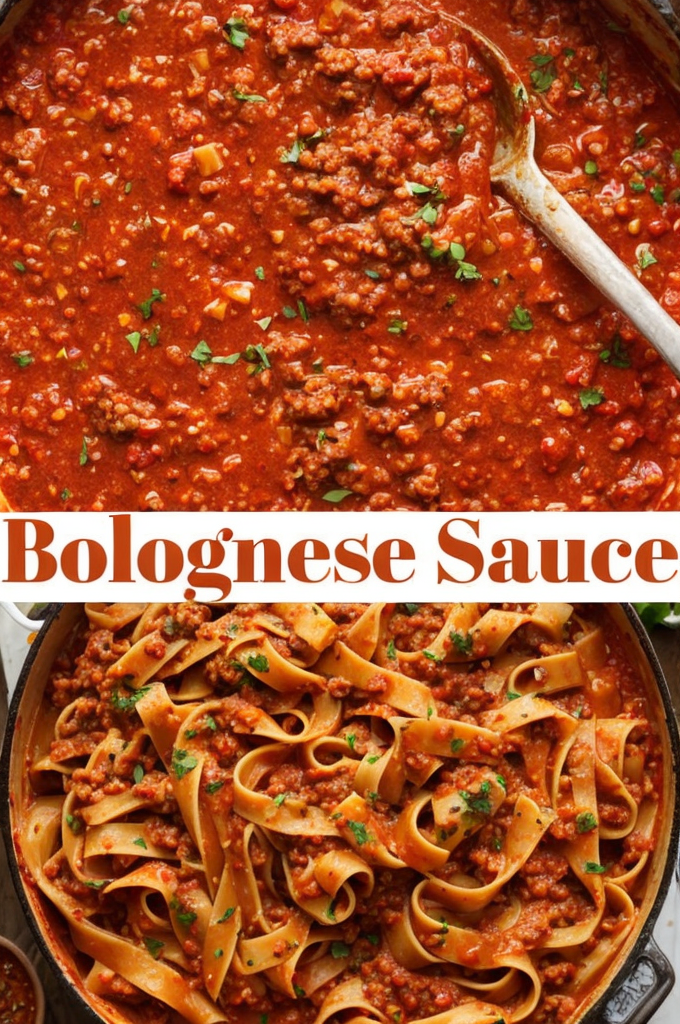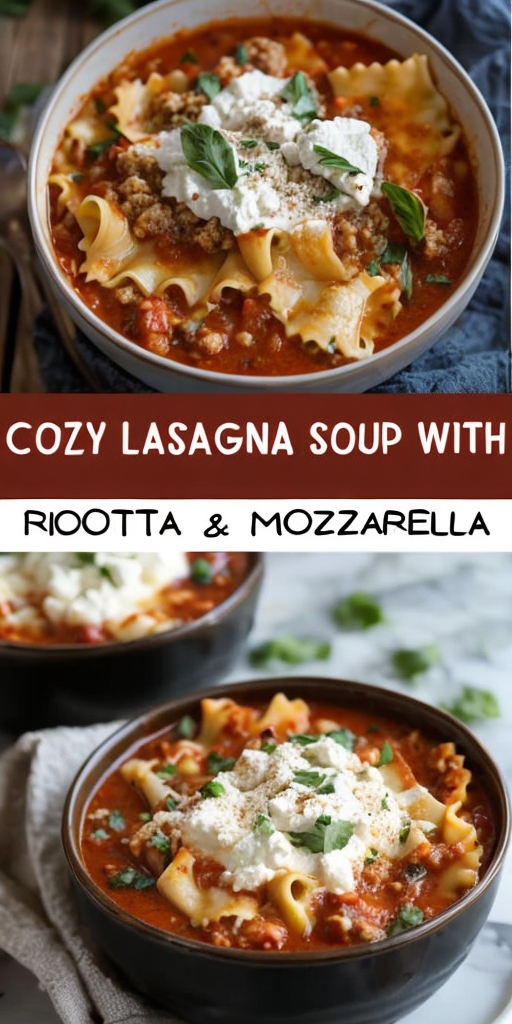Best Bolognese Sauce – Family Favorite Recipe
Best Bolognese Sauce – A Family Favorite Recipe
Dive into the heartwarming flavors of the Best Bolognese Sauce, a family favorite recipe that brings the authentic taste of Italy right to your dining table. Rich and savory, this sauce combines a medley of aromatic vegetables, tender meats, and luscious tomatoes slow-cooked to perfection. It’s an irresistible dish that fills your kitchen with an inviting aroma, creating an experience that goes beyond just a meal. Whether you’re serving it over pasta or using it as a filling for lasagna, this bolognese sauce is sure to become a staple in your culinary repertoire.
Quick Recipe Highlights
- Flavor Profile: A harmonious blend of rich tomatoes, tender meat, and aromatic vegetables, perfectly seasoned with herbs and wine.
- Texture: Smooth and velvety with a chunky consistency, ensuring a delightful bite in every mouthful.
- Aroma: A captivating mix of garlic, onions, herbs, and wine fills the kitchen, setting a cozy and inviting ambiance.
- Visual Appeal: A vibrant, rustic red with specks of green herbs and golden meat, promising a visually satisfying dish.
- Skill Level Needed: Intermediate, requiring basic sautéing and simmering techniques to balance flavors effectively.
- Special Equipment: A sturdy pot for long simmering, ensuring even cooking and deep flavor development.
Recipe Overview
- Difficulty Level: Medium. The recipe involves several steps to ensure the deep flavors develop properly, but the techniques are straightforward enough for confident home cooks.
- Category: Main Course. A substantial dish perfect for family dinners or cozy gatherings, served best with pasta or bread.
- Cuisine: Italian. This recipe takes inspiration from the traditional Bolognese sauces of Northern Italy, emphasizing slow-cooked meats and rich tomato flavors.
- Cost: Moderate. While the recipe does involve a few ingredients, they are widely accessible and provide generous servings, making it cost-effective.
- Season: Best enjoyed in cooler months, as the slow-cooked sauce brings warmth and comfort to the table. However, it’s a year-round favorite for many.
- Occasion: Ideal for family dinners, holiday feasts, or as a make-ahead meal for weeknights, offering both comfort and elegance.
Why You’ll Love This Recipe
Crafting this Best Bolognese Sauce is a culinary journey that results in a symphony of flavors and textures. The melding of beef and pork, combined with hearty tomatoes, creates a robust sauce that is deliciously rich. The mouthfeel is creamy yet chunky, providing a balance that satisfies both sauce and solid textures. It’s perfectly complemented by al dente pasta, making every bite an extraordinary delight.
The recipe is designed with convenience in mind. After a brief preparation time, the sauce primarily cooks itself, allowing you to attend to other tasks or simply relax. It pairs wonderfully with a variety of pasta types, making it a versatile dish that adjusts to your pantry’s needs. Plus, it’s a fantastic make-ahead dish, with flavors that deepen overnight.
Nutritionally, the Bolognese sauce is rich in proteins and can be adjusted to fit various dietary requirements. By simply altering the meat content or incorporating hearty vegetables, the dish maintains its delicious profile while catering to different nutritional needs.
Socially, this Bolognese sauce is a crowd-pleaser, fitting seamlessly into both casual dinners and formal settings. It’s a recipe that invites diners to gather, share stories, and enjoy moments, enriching bonds over food. With its savory allure, there’s no doubt this dish will be the highlight of your gatherings.
Finally, the cost-effectiveness of this dish makes it a winner. The ingredients are accessible and budget-friendly, allowing you to feed a crowd or have leftovers for subsequent meals without breaking the bank. Its simplicity and affordability make it a go-to family favorite that doesn’t compromise on taste or quality.
Historical Background and Cultural Significance
The origin of Bolognese sauce, or Ragù alla Bolognese, traces back to Bologna, a charming city in northern Italy. Deeply rooted in Italian culinary traditions, it has been refined over generations, reflecting the richness of its homeland’s cuisine. The recipe has evolved from a hearty meat stew to a sophisticated sauce punctuated with soft, nuanced flavors.
Culturally, Bolognese sauce holds significant importance as a symbol of Italian hospitality and family gatherings. Traditionally served over tagliatelle, it is a dish that brings people together, celebrating the vibrancy of Italian life. It encapsulates the philosophy of nurturing through food and highlights the Italian approach of taking joy in simple pleasures.
Over time, Bolognese sauce has undergone various adaptations, both regionally in Italy and globally. While the traditional recipe emphasizes meat, wine, and a touch of milk or cream, different regions incorporate their local ingredients. For example, some may add pancetta or various herbs, creating a distinctly unique taste profile.
The variations of Bolognese around the world showcase the adaptability of this beloved sauce. From American spaghetti Bolognese, typically featuring a tomato-heavy base, to lighter, vegetable-rich versions for vegan diets, each adaptation tells a unique story while honoring its Italian roots.
Ingredient Deep Dive
The foundation of any outstanding Bolognese sauce begins with high-quality meat. Ground beef and pork blend harmoniously, providing a balance of flavors and fat that enriches the sauce. Beef offers a robust taste rich in umami, while pork adds a touch of sweetness and tender texture. Selecting meats with a moderate fat content ensures a moist and flavorful sauce.
Tomatoes are the vibrant core of Bolognese, contributing to its luscious red color and tangy undertone. Using canned whole peeled tomatoes is recommended for convenience and consistency. When selecting, opt for products without additives for the purest flavor. Storing in a cool, dry place will maintain their quality, and if unavailable, tomato purée is a fine substitute.
Common Mistakes to Avoid
- Skipping the sauté: Ensure vegetables are sautéed until soft and aromatic; this step significantly enhances flavor depth.
- Rushing the simmer: Bolognese needs time; a quick boil will not achieve the desired richness and complexity.
- Improper meat browning: Browning meat thoroughly creates the savory base essential for a sumptuous sauce.
- Using lean meat exclusively: A mix of lean and fatty meats ensures your sauce remains juicy and flavorful.
- Overloading seasonings: Bolognese is about balanced flavors; avoid overpowering with too many herbs or spices.
- Ignoring the milk step: Milk softens the acidity and adds richness; don’t skip incorporating it towards the end.
- Using weak stock: A robust beef or chicken stock enriches the sauce, adding depth to the overall taste.
- Insufficient stirring: Stir occasionally to prevent sticking and ensure even cooking throughout the simmering process.
Essential Techniques
Sauté is an essential technique in developing a complex flavor profile for your Bolognese. Start with finely chopped vegetables like onions, carrots, and celery, cooking them gently in olive oil. The process is crucial for releasing their natural sweetness and building a nuanced flavor base. Mastering this technique allows the sauce to start off with a robust and aromatic foundation.
Deglazing is another critical step. After browning the meat, use wine to deglaze the pot, lifting off the caramelized bits for an enriched flavor. This technique helps integrate those delicious residues into the sauce, creating a profound umami taste spread throughout the dish. Use a spatula to scrape the browned bits while the wine simmers and infuses its essence.
Pro Tips for Perfect Bolognese Sauce
Choose high-quality canned tomatoes for richer flavor and consistency. San Marzano tomatoes are an excellent choice for their sweet, less acidic profile, adding depth to the sauce.
Allow the sauce to sit overnight. Like many hearty dishes, this Bolognese improves with time, as flavors meld and deepen when left to rest for a day.
Consider using a combination of meats, such as veal, beef, and pork, for a more nuanced flavor and texture, offering layers of savoriness and tenderness.
Always finish with grated Parmigiano-Reggiano. It adds a nutty, savory element that reinforces the sauce’s richness.
If you’re short on time, use a pressure cooker to speed up the cooking process while still developing complex layers of flavor.
Incorporate a splash of cream at the end of cooking to add richness and balance acidity, providing a velvety finish to the sauce.
Variations and Adaptations
Regional variations of Bolognese include integrating pancetta or prosciutto for an added punch of flavor. Some Southern Italian versions might use fresh basil for a summery twist, whereas Northern adaptations may see the addition of wine-rich stocks, creating a fuller profile. Seasonally, you can adapt the sauce with mushrooms in fall or add roasted cherry tomatoes in summer for an extra sweet and vibrant touch.
For dietary modifications, try substituting meats with lentils or mushrooms for a satisfying vegetarian Bolognese. These ingredients maintain the sauce’s hearty nature while offering a plant-based alternative. Flavors can be further enhanced with soy sauce for depth, maintaining the Bolognese’s characteristic savoriness.
Serving and Presentation Guide
Presenting your Bolognese sauce elegantly begins with selecting the right pasta. Tagliatelle or pappardelle are traditional choices, with their broad ribbons capturing the sauce beautifully. For a modern twist, consider serving Bolognese over zucchini noodles or polenta for a unique presentation.
Garnish with fresh basil leaves or a light shaving of aged pecorino for added visual and flavor appeal. Traditional Italian bread makes for an excellent accompaniment, allowing guests to savor every last drop of this rich sauce. For a touch of elegance, serve on white porcelain plates, enhancing the vibrant color contrast of the sauce.
Wine and Beverage Pairing
A classic Bolognese sauce pairs beautifully with medium-bodied red wines such as Chianti, Barbera, or Sangiovese. These wines’ bright acidity complements the sauce’s richness without overpowering its delicate flavors. For non-alcoholic options, consider a robust iced tea or sparkling water with a hint of citrus to cleanse the palate. Maintain beverages at room temperature, allowing their natural flavors to enhance your dining experience.
Storage and Shelf Life
For optimal storage, transfer your Bolognese sauce into airtight containers and refrigerate. It can be safely stored for up to four days, with flavors intensifying over time. For longer storage, freeze the sauce in individual portions for up to three months, ensuring it’s sealed well to prevent freezer burn. Thaw in the refrigerator overnight, then reheat gently on the stove, adding a touch of stock or water if needed to return the sauce to its desired consistency.
Make Ahead Strategies
Preparing Bolognese sauce a day ahead not only saves time but enhances its flavor, allowing the components to meld beautifully. Once the sauce is cooked, let it cool completely before transferring to storage containers. While refrigerating, keep an eye on humidity, placing a paper towel beneath the lid to absorb any excess moisture. When ready to serve, gently reheat and finish with fresh parsley or cheese, adding a burst of freshness to your meal.
Scaling Instructions
When considering halving the recipe, maintain the proportions of vegetables and meat, ensuring the sauce retains its consistency. For larger gatherings, double or triple the recipe, using larger pots and perhaps adjusting cooking times slightly, keeping in mind that flavor development remains key. Ensure thorough cooking by occasionally stirring and checking seasoning, balancing layers of flavor even when scaling.
Nutritional Deep Dive
The Best Bolognese Sauce offers a balanced macronutrient profile, rich in protein from ground meat and wholesome carbohydrates when paired with pasta. Its traditional preparation provides vitamins A and C from tomatoes and vegetables, while the meat contributes iron and zinc. Adjust portions according to dietary needs, allowing for a guilt-free indulgence while understanding the sauce’s nutritional benefits through mindful ingredient selection and serving size control.
Dietary Adaptations
To create a gluten-free Bolognese, swap traditional wheat pasta for rice or quinoa-based alternatives, maintaining the sauce’s hearty consistency. For a dairy-free version, omit the optional finishing cream and opt for a cream alternative or additional olive oil. While the sauce naturally fits into low-carb or keto diets, pairing it with zoodles or shirataki noodles offers a delicious, carb-conscious dish.
The Recipe
Best Bolognese Sauce
Serves: 6
Prep Time: 15 mins
Cook Time: 2 hours 30 mins
Total Time: 2 hours 45 mins
Kitchen Equipment Needed
- Large heavy-bottomed pot
- Wooden spoon
- Chef’s knife
- Measuring cups and spoons
Ingredients
- 2 tablespoons olive oil
- 1 medium onion, finely chopped
- 2 carrots, diced
- 2 celery stalks, diced
- 500g ground beef
- 250g ground pork
- 2 cups whole peeled tomatoes, crushed
- 1 cup white wine
- 1 cup beef or chicken stock
- 1 cup whole milk
- 2 bay leaves
- Salt and pepper to taste
- Fresh basil, for garnish
Directions
- Heat olive oil in a large pot over medium heat. Add onions, carrots, and celery; sauté until softened.
- Increase heat to medium-high and add ground beef and pork. Cook until browned, breaking up with a spoon.
- Stir in the wine, scraping any bits off the pot’s bottom. Allow the wine to evaporate slightly.
- Mix crushed tomatoes, stock, and bay leaves. Bring to a simmer, reduce heat to low, and cover.
- Cook for 2-2.5 hours, occasionally stirring to prevent sticking.
- Stir in milk, season with salt and pepper. Simmer for an additional 10 minutes.
- Remove bay leaves and serve over pasta, garnished with fresh basil.
Recipe Notes
- To create a richer sauce, use a mix of half ground beef and half Italian sausage.
- For a splash of freshness, add a handful of chopped parsley before serving.
Troubleshooting Guide
Flavor balance can be tricky; if your sauce is too acidic, try adding a pinch of sugar to balance. For overly salty flavors, introduce a diced potato into the sauce and let it cook; the starch will absorb some salt. Texture issues such as a dry consistency can be resolved by adding extra stock or cream, ensuring the sauce remains moist and rich.
Recipe Success Stories
Enthusiastic feedback has poured in from readers worldwide, who have embraced the flexibility of this Best Bolognese Sauce. Many have shared their delightful adaptations, whether by adding pancetta, using beef alternatives, or infusing the sauce with exotic spices. Readers have also expressed joy in seeing how kids relish the sauce, with chefs often receiving compliments on the sauce’s stability and deep flavors.
Frequently Asked Questions
Yes, turkey is a leaner alternative that can reduce the sauce’s overall fat content. Adjust seasoning if necessary to maintain flavor richness.
How do I prevent the sauce from sticking?
Consistent stirring and using a quality, heavy-bottomed pot can prevent sticking. Keeping the heat low is also crucial during long simmering periods.
What wine is best for this sauce?
A dry white wine like Sauvignon Blanc or Pinot Grigio enhances the sauce without overpowering its flavor profile.
Is it necessary to use milk in the recipe?
Milk gives the sauce a creamy texture and mellows the acidity of the tomatoes. Substitutes like almond milk can be used for dairy-free versions.
Can the sauce be made in larger batches and frozen?
Absolutely. The sauce freezes well; ensure it’s completely cool before portioning into airtight containers for freezing.
Is it better to chop or blend the vegetables?
Chopping provides texture, whereas blending creates a smoother finish. It depends on personal preference and desired final texture.
Can I make this sauce spicy?
Sure! Add chili flakes or chopped fresh chili during the initial sauté for a spicy kick, adjusting the quantity to your heat preference.
How can I add a smoky flavor?
A dash of smoked paprika or using smoked bacon adds a wonderful smoky undertone to the sauce.
What pasta pairs best with this sauce?
Tagliatelle or pappardelle are traditional, but any pasta with grooves or ridges will complement the sauce’s thickness.
How do I store leftovers?
Refrigerated leftovers should be used within 3-4 days. Ensure storage in an airtight container to preserve flavor and moisture.
Additional Resources
If you loved this Bolognese sauce, explore our collection of Italian pasta dishes that pair perfectly with the sauce, including homemade tagliatelle and ricotta gnocchi. Dive into guides detailing the art of pasta-making or browse seasonal ingredient spotlights for a deeper understanding of Italian herbs and spices. We also offer readers insights into selecting cookware that enhances flavor development in stews and sauces.
Join the Conversation
We invite you to share your creations and variations of this Bolognese sauce on our social media platforms. Use our hashtag for a chance to be featured in our community highlights, showcasing your unique presentations and innovations. Your feedback and ideas serve as inspiration, helping us all explore the endless possibilities of this traditional Italian favorite.






